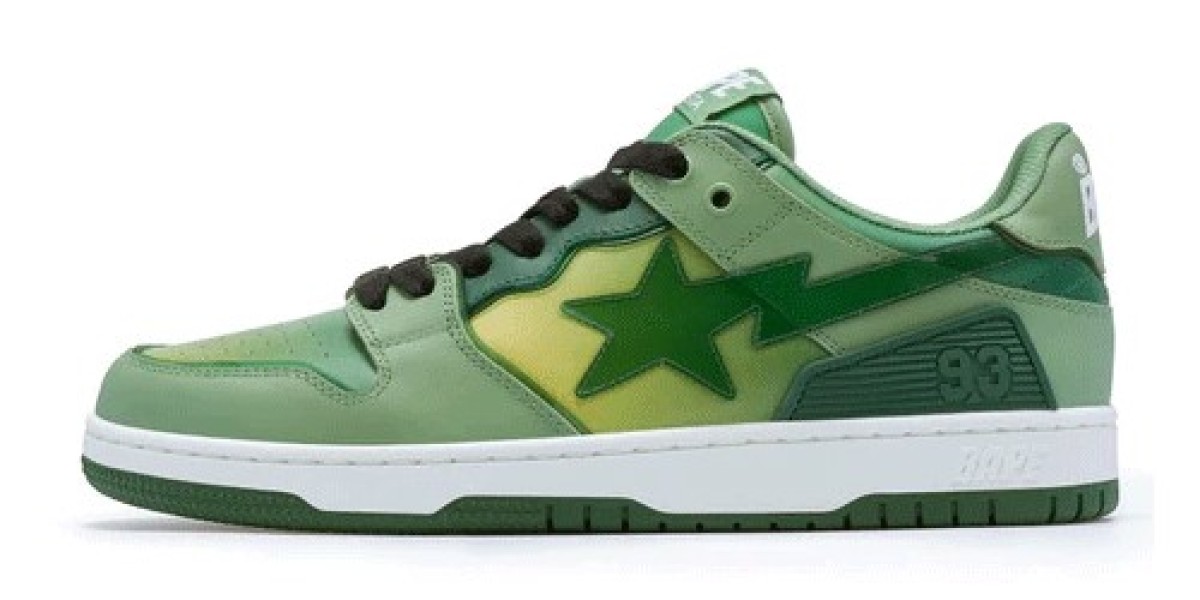The world of streetwear is filled with iconic pieces that not only shape trends but define generations. Among these, the Bapesta sneaker by A Bathing Ape (commonly known as BAPE) holds a unique place. With its unmistakable silhouette, star-studded side logo, and vibrant colorways, the Bapesta has evolved beyond footwear into a cultural symbol. Since its launch in the early 2000s, the Bapesta has walked the line between homage and innovation, often sparking conversation among fashion critics and fans alike.
In this article, we take a closer look at what makes the Bapesta such a revered sneaker in both the fashion and streetwear scenes. From its roots in Harajuku to its modern-day collaborations with global celebrities and brands, the journey of the Bapesta is anything but ordinary.
The Origins of Bapesta: A Sneaker Born in Harajuku
Founded by Nigo in 1993, A Bathing Ape quickly established itself as a cornerstone of Tokyo’s Harajuku streetwear movement. The brand’s playful use of pop culture references, camouflage prints, and bold branding earned it a cult following in Japan and, eventually, worldwide. But it wasn’t until 2002 that BAPE truly disrupted the sneaker scene with the launch of the Bapesta.
At first glance, the Bapesta resembles another iconic sneaker: the Nike Air Force 1. The shape, sole design, and paneling are nearly identical, which led to plenty of debate over whether it was simply a knockoff or a clever reinterpretation. However, Nigo never shied away from the comparison. In fact, the Bapesta was intentionally created as a tribute to American hip-hop and sneaker culture, particularly the Air Force 1, which dominated the streets of New York in the late ‘90s.
What set the Bapesta apart was its audacious flair. Patent leather uppers in neon colors, the signature star logo in place of Nike’s Swoosh, and limited-edition drops created a new level of exclusivity. It was flashy, bold, and undeniably Japanese in its approach to Western aesthetics.
Bapesta and Hip-Hop: A Mutual Love Affair
From the beginning, Bapesta sneakers were never just about fashion—they were about identity. Nigo’s deep ties to hip-hop played a major role in the sneaker's rise. Pharrell Williams, Kanye West, Lil Wayne, and Soulja Boy were all early adopters of the brand. Pharrell’s friendship with Nigo led to collaborations through Billionaire Boys Club, amplifying BAPE’s presence in the American market.
One of the most iconic moments in the Bapesta timeline was when Kanye West dropped his own version of the shoe in 2007. Before Yeezys took over the sneaker world, Kanye’s Bapesta was a status symbol—a sign that you were not only tuned into fashion but ahead of the curve.
Rappers and musicians embraced the sneaker not just for its style but for what it represented: a merging of cultures, a bridge between East and West, and a rebellion against traditional sneaker norms. The Bapesta became synonymous with luxury streetwear long before the term was mainstream.
Evolution Through Collaboration
Like many iconic sneakers, the Bapesta has remained relevant thanks to its strategic collaborations. Over the years, BAPE has teamed up with some of the biggest names in fashion, entertainment, and pop culture to reinterpret the sneaker.
Partnerships with brands like Marvel, Comme des Garçons, and Undefeated brought fresh perspectives to the silhouette. BAPE also collaborated with artists and musicians including Kid Cudi, Travis Scott, and J Balvin, allowing each to inject their own style into the Bapesta while staying true to the shoe’s roots.
One notable aspect of these collaborations is how they maintain BAPE’s limited-run philosophy. By releasing small batches of highly coveted designs, the brand fuels the hype culture that thrives on scarcity. Sneaker drops often sell out within minutes, and resale markets skyrocket, proving that the Bapesta is still one of the most desired sneakers in the game.
The Resurgence of Bapesta in Modern Streetwear
While Bapesta never completely disappeared from the fashion radar, it saw a notable resurgence in the late 2010s and early 2020s. As Y2K fashion returned to popularity, so did the loud and expressive styles that defined early 2000s streetwear. Bapesta, with its eye-catching designs and nostalgic appeal, fit perfectly into the trend.
Today’s fashion influencers, TikTok creators, and sneaker collectors frequently showcase Bapestas in outfit breakdowns, hauls, and styling videos. The sneaker’s bold colors and retro vibe make it a natural fit for digital aesthetics and social media fashion.
BAPE also reintroduced updated versions of the Bapesta, featuring modern materials, improved construction, and new design motifs. This balance of honoring the original while evolving with current trends keeps the sneaker both rooted and progressive.
How Bapesta Changed Sneaker Culture
The Bapesta didn’t just change how sneakers looked—it changed how they were perceived. Prior to BAPE’s global breakthrough, the sneaker world was largely dominated by American and European brands. BAPE’s entry into the scene not only disrupted the status quo but made room for Asian fashion houses to be recognized as global powerhouses.
The sneaker also blurred the lines between luxury fashion and streetwear. With BAPE stores offering not just shoes, but exclusive apparel, accessories, and even lifestyle products, the brand redefined what a streetwear label could be. Today, the influence of BAPE and the Bapesta can be seen in brands like Off-White, Supreme, and Fear of God—all of which embrace the same ethos of limited drops, bold branding, and cultural integration.
Collectors now view early Bapesta releases as grails. Older models can fetch thousands of dollars on secondary markets, making them as coveted as vintage Jordans or OG Yeezys. This demand has made the Bapesta not just a fashion statement, but an investment piece in the world of sneakers.
Styling the Bapesta: Modern Ways to Rock an Icon
One of the greatest strengths of the Bapesta is its versatility. Despite its bold design, it can be styled in various ways to reflect different fashion identities. Streetwear purists pair it with oversized hoodies, cargo pants, and vintage graphic tees, while modern minimalists contrast the colorful sneaker with neutral fits to let it stand out.
Layering is key when building a look around a Bapesta. A sleek bomber jacket over a monochrome tracksuit, with a vibrant Bapesta on foot, creates a balanced yet dynamic outfit. Others choose to match their Bapestas with coordinating accessories like caps, bags, or even sunglasses—especially from BAPE’s expansive lifestyle catalog.
No matter how it’s worn, the Bapesta remains a statement. It tells the world that the wearer appreciates fashion history, values creativity, and isn’t afraid to stand out.
Conclusion: Why the Bapesta Will Always Be More Than Just a Sneaker
The Bapesta is more than a shoe. It’s a time capsule of fashion innovation, cultural exchange, and rebellious style. From its controversial beginning to its current resurgence, it has maintained its identity in a constantly changing landscape.
In a world oversaturated with sneakers, very few silhouettes manage to retain authenticity and relevance across decades. The Bapesta is one of those rare exceptions. It continues to inspire designers, attract collectors, and dominate conversations—not just for what it is, but for what it represents.
For anyone looking to understand the DNA of modern streetwear or the global evolution of sneaker culture, the Bapesta is essential study material. It’s not just footwear—it’s a fashion revolution that started with a star and never stopped shining.













